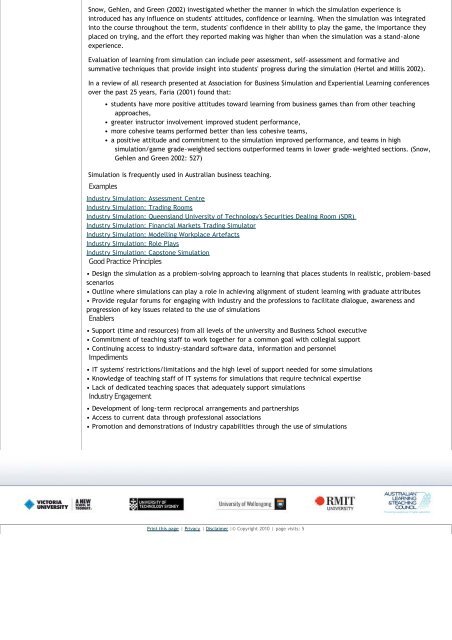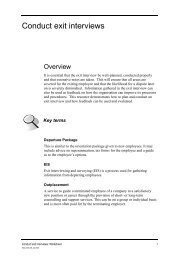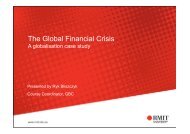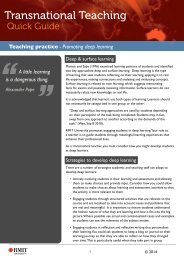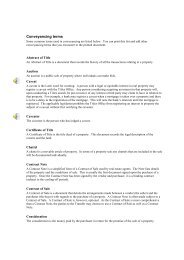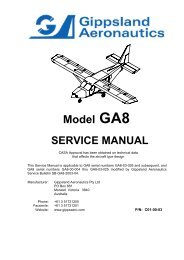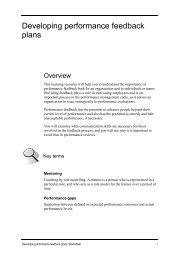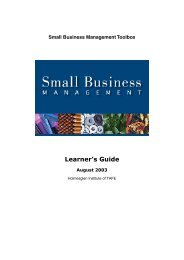PDF of website - Bad Request - RMIT University
PDF of website - Bad Request - RMIT University
PDF of website - Bad Request - RMIT University
Create successful ePaper yourself
Turn your PDF publications into a flip-book with our unique Google optimized e-Paper software.
Snow, Gehlen, and Green (2002) investigated whether the manner in which the simulation experience is<br />
introduced has any influence on students' attitudes, confidence or learning. When the simulation was integrated<br />
into the course throughout the term, students' confidence in their ability to play the game, the importance they<br />
placed on trying, and the effort they reported making was higher than when the simulation was a stand-alone<br />
experience.<br />
Evaluation <strong>of</strong> learning from simulation can include peer assessment, self-assessment and formative and<br />
summative techniques that provide insight into students' progress during the simulation (Hertel and Millis 2002).<br />
In a review <strong>of</strong> all research presented at Association for Business Simulation and Experiential Learning conferences<br />
over the past 25 years, Faria (2001) found that:<br />
students have more positive attitudes toward learning from business games than from other teaching<br />
approaches,<br />
greater instructor involvement improved student performance,<br />
more cohesive teams performed better than less cohesive teams,<br />
a positive attitude and commitment to the simulation improved performance, and teams in high<br />
simulation/game grade-weighted sections outperformed teams in lower grade-weighted sections. (Snow,<br />
Gehlen and Green 2002: 527)<br />
Simulation is frequently used in Australian business teaching.<br />
Examples<br />
Industry Simulation: Assessment Centre<br />
Industry Simulation: Trading Rooms<br />
Industry Simulation: Queensland <strong>University</strong> <strong>of</strong> Technology's Securities Dealing Room (SDR)<br />
Industry Simulation: Financial Markets Trading Simulator<br />
Industry Simulation: Modelling Workplace Artefacts<br />
Industry Simulation: Role Plays<br />
Industry Simulation: Capstone Simulation<br />
Good Practice Principles<br />
• Design the simulation as a problem-solving approach to learning that places students in realistic, problem-based<br />
scenarios<br />
• Outline where simulations can play a role in achieving alignment <strong>of</strong> student learning with graduate attributes<br />
• Provide regular forums for engaging with industry and the pr<strong>of</strong>essions to facilitate dialogue, awareness and<br />
progression <strong>of</strong> key issues related to the use <strong>of</strong> simulations<br />
Enablers<br />
• Support (time and resources) from all levels <strong>of</strong> the university and Business School executive<br />
• Commitment <strong>of</strong> teaching staff to work together for a common goal with collegial support<br />
• Continuing access to industry-standard s<strong>of</strong>tware data, information and personnel<br />
Impediments<br />
• IT systems' restrictions/limitations and the high level <strong>of</strong> support needed for some simulations<br />
• Knowledge <strong>of</strong> teaching staff <strong>of</strong> IT systems for simulations that require technical expertise<br />
• Lack <strong>of</strong> dedicated teaching spaces that adequately support simulations<br />
Industry Engagement<br />
• Development <strong>of</strong> long-term reciprocal arrangements and partnerships<br />
• Access to current data through pr<strong>of</strong>essional associations<br />
• Promotion and demonstrations <strong>of</strong> industry capabilities through the use <strong>of</strong> simulations<br />
Print this page | Privacy | Disclaimer |© Copyright 2010 | page visits: 5


